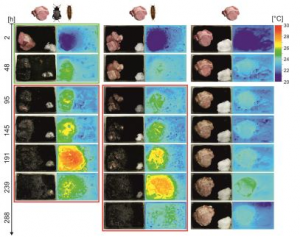In the paper published in Frontiers in Zoology (https://rdcu.be/cTJ0n) Szymon Matuszewski and Anna Mądra-Bielewicz described the way in which necrophagous beetles Necrodes littoralis (Silphidae) produce heat on cadavers. Both adult and larval beetles form greasy feeding matrix, in which heat is produced. The matrix formed by adult beetles improves thermal conditions in the environment where the larvae feed.
Some necrophagous beetles in the Silphidae family form greasy feeding matrix by spreading over cadaver/meat surface anal and oral exudates. In this study we tested the hypothesis that the matrix formed by Necrodes littoralis beetles produces heat that enhances fitness of the beetles. Using thermal imaging we demonstrate that heat produced in the matrix formed on meat by the beetles is larger than in meat that decomposed without the insects. Larval beetles regularly warm up in the matrix. Moreover, by comparing matrix temperature and larval fitness in colonies with and without preparation of meat by adult beetles, we provide evidence that formation of the matrix by adult beetles has positive and deferred thermal effects for larval microhabitat. We found an increase in heat production of the matrix and a decrease in development time and mortality of larvae after adult beetles formed the matrix on meat in the pre-larval phase.
